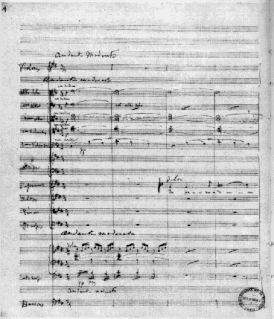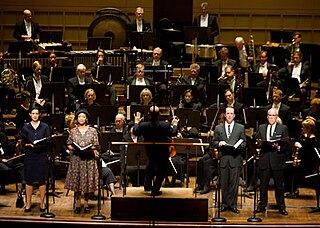Composition
Background
Harbison composed the first sketches of what would become his Requiem in early 1985. The music was written on the opposite side of a page that also contained the first passages his 1999 opera The Great Gatsby . Like The Great Gatsby, the Requiem wouldn't be completed for over a decade.
The Great Gatsby is an opera in two acts written by American composer John Harbison. The libretto, also by Harbison, was adapted from the novel The Great Gatsby by F. Scott Fitzgerald. Additional popular song lyrics were by Murray Horwitz. The opera was commissioned by the Metropolitan Opera in honor of music director James Levine's 25th anniversary with the company.
He composed much of the "Introit" over the course of 1985, but didn't return to the work until 1991, when he wrote a piece that would become the basis for the "Sanctus" on a commission from The Rivers School Conservatory. Harbison misplaced the score, however, requiring him to present a different piece for the school. He wouldn't find the sheet music of the "Sanctus" until seven years later.
Later, in 1995, Harbison was one of thirteen international composers commissioned by Internationale Bachakademie Stuttgart to write a movement for the collective Requiem of Reconciliation to commemorated the victims of World War II. Harbison was assigned the "Recordare" section (then titled "Juste judex" [4] ), which he based on musical ideas he had earlier developed for the "Introit."
Internationale Bachakademie Stuttgart is a foundation in Stuttgart, founded by Helmuth Rilling in 1981 to foster international concerts and workshops, namely Musikfest Stuttgart, dedicated especially to the music of Johann Sebastian Bach in relation to present day composition. Its director has been Hans-Christoph Rademann from 1 June 2013.
The Requiem of Reconciliation was a collaborative work written to commemorate the 50th anniversary of the end of World War II. It sets the Catholic mass for the dead in fourteen sections, each written by a different composer from a country involved in the war. It was commissioned by the Internationale Bachakademie Stuttgart in Stuttgart, Germany, and first performed by the Gächinger Kantorei, the Krakauer Kammerchor and the Israel Philharmonic Orchestra, conducted by Helmuth Rilling. A two-CD set documenting this performance was released in 1996.

World War II, also known as the Second World War, was a global war that lasted from 1939 to 1945. The vast majority of the world's countries—including all the great powers—eventually formed two opposing military alliances: the Allies and the Axis. A state of total war emerged, directly involving more than 100 million people from over 30 countries. The major participants threw their entire economic, industrial, and scientific capabilities behind the war effort, blurring the distinction between civilian and military resources. World War II was the deadliest conflict in human history, marked by 50 to 85 million fatalities, most of whom were civilians in the Soviet Union and China. It included massacres, the genocide of the Holocaust, strategic bombing, premeditated death from starvation and disease, and the only use of nuclear weapons in war.
Then, in 1999, he "very spontaneously" composed a "Hostias" section and was motivated to finish the Requiem. Finally, a 2001 commission from the Boston Symphony Orchestra allowed him to complete the work.

The Boston Symphony Orchestra (BSO) is an American orchestra based in Boston, Massachusetts. It is one of the five major American symphony orchestras commonly referred to as the "Big Five". Founded in 1881, the BSO plays most of its concerts at Boston's Symphony Hall and in the summer performs at Tanglewood.
The Latin text of the Requiem is set to traditional sections of the Requiem Mass, scripture, and a medieval poem "all added in at different times, but acquiring a weight and dignity through use and age." The composer wrote, "I wanted a sense of ancient inheritance to inhabit my setting: a ritual steeped in the inevitability of death – gradually moving toward consolation and acceptance."
Harbison composed the piece through the initial shock and aftermath of the September 11 attacks, causing him to reflect on the meaning of the composition. He recalled, "My account of the genesis of the piece makes it clear that its sources go back fifteen years. But the events of that fall made my purposes clearer. I wanted my piece to have a sense of the inexorability of the passage of time, for good and ill, of the commonality of love and loss. I wanted to open up an aural space where this could be acknowledged." He continued:
Ideally this piece is not coercively about how you should feel, but rather an offer of a place to be true to your own thoughts. I inscribed, as I wrote this piece over seventeen years, the names of loved ones who died in that time, not to tell the listener about my reaction, but to remind myself that only living alertly in our own immediate lives gives us any comprehension of war, disaster, destruction on a wider scale. I wanted a way to jump with the text from past to present to future, from they to we to I. [1]
Structure
The Requiem has a duration of approximately 58 minutes and is composed in two parts comprising thirteen smaller movements: [1]
Part I
- Introit
- Sequence I: Dies irae
- Sequence II: Tuba mirum
- Sequence III: Liber scriptus
- Sequence IV: Quid sum miser
- Sequence V: Recordare
- Sequence VI: Confutatis – Lacrymosa
Part II
- Offertorium
- Sanctus
- Agnus Dei
- Lux aeterna
- Libera me
- In paradisum
Harbison described the two parts as "an accidental collection of words about mortality (part I) and continuity (part II), to be shaped into a purposeful collection of sounds." [1]
Instrumentation
The work is scored for solo soprano, mezzo-soprano, tenor, baritone, SATB chorus, and an orchestra consisting of two flutes (2nd doubling piccolo), two oboes, two clarinets, two bassoons (2nd doubling contrabassoon), two horns, two trumpets, three trombones, timpani, three percussionists, piano (doubling celesta), harp, and strings. [1]









